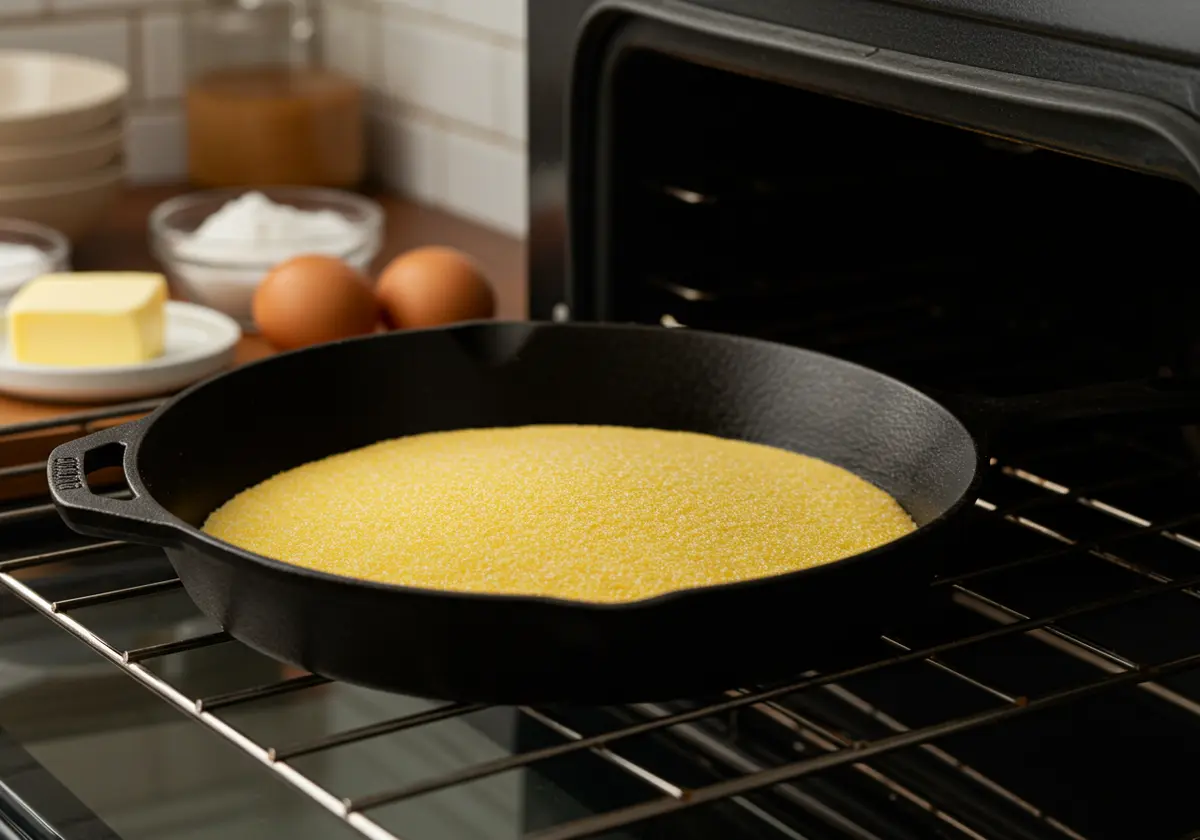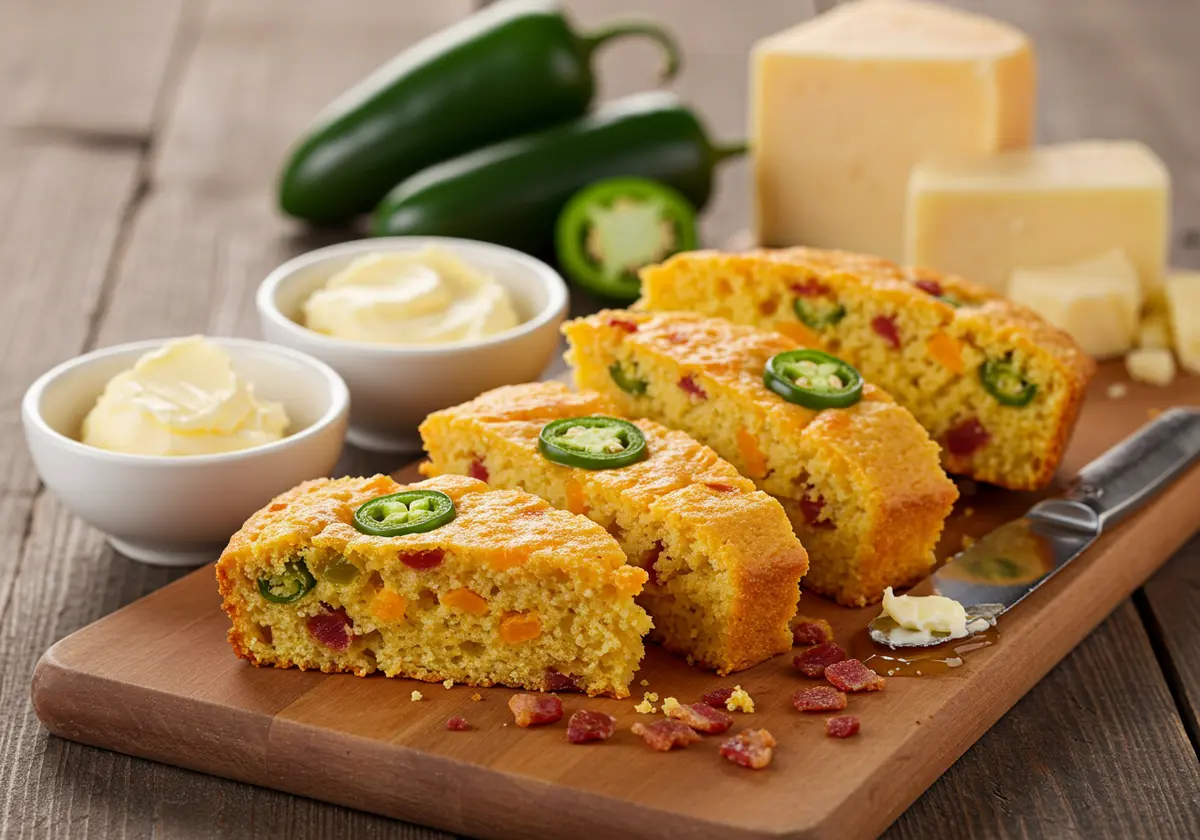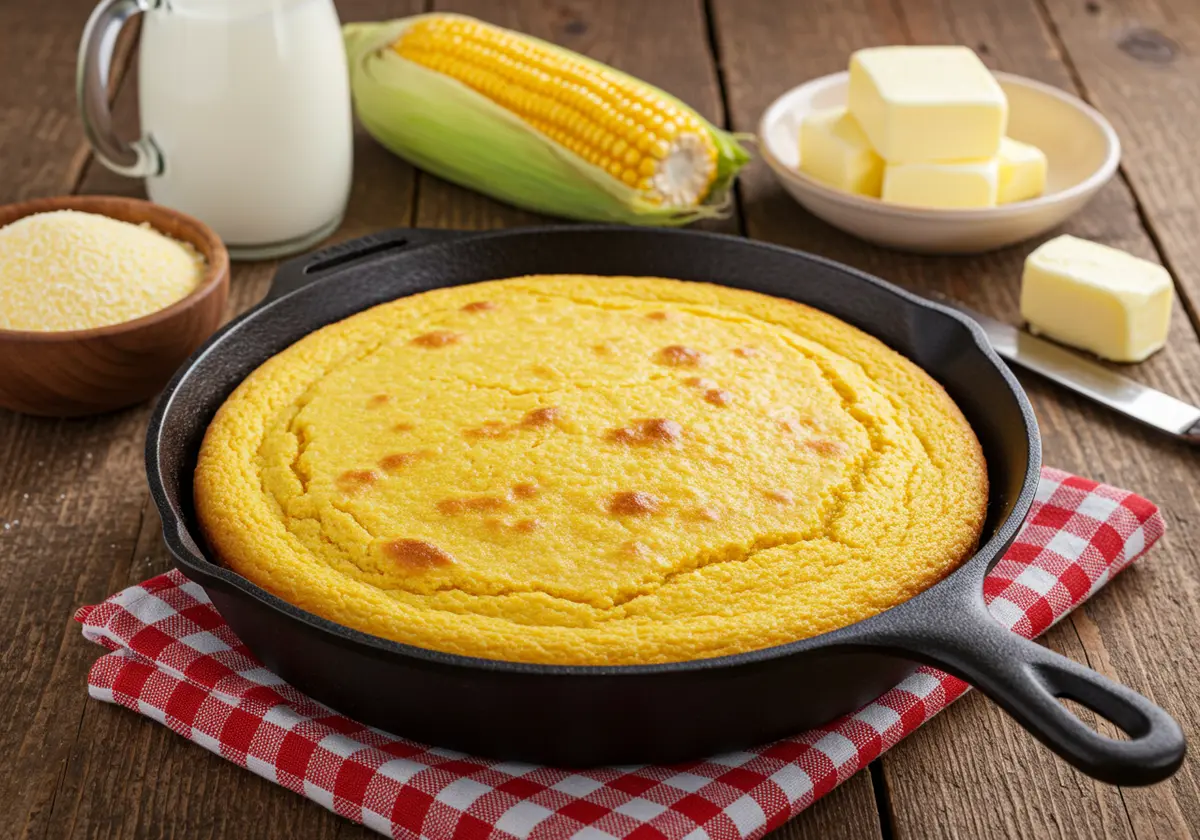Traditional Cornbread Recipe – The Ultimate Guide
Cornbread has a way of bringing people together, whether it’s served alongside a hearty bowl of chili or as a side at a classic backyard barbecue. This article delves into everything you need to know about making the perfect traditional cornbread recipe—from its origins to step-by-step instructions, plus tips for nailing that golden crust. Whether you’re a novice baker or a seasoned pro, this guide has you covered.
Introduction to Traditional Cornbread Recipe
What is Cornbread?
Cornbread is a simple yet flavorful quick bread made primarily from cornmeal. It’s a cornerstone of American cuisine, beloved for its crumbly texture and versatility. Whether baked in a skillet or an oven pan, cornbread is a quintessential comfort food that can be tailored to suit sweet or savory tastes. It’s a dish that shines in its simplicity yet leaves room for endless creativity.
Historical Origins of Cornbread
The roots of traditional cornbread recipes trace back to Native American cooking, where ground corn was a dietary staple. Early settlers adopted and adapted these recipes, creating versions like “Johnnycakes” and “ash cakes.” Over time, cornbread became a staple in Southern households, evolving into the rich, buttery, and sometimes sweetened variations we know today.
Why Cornbread is a Staple in American Cuisine
Cornbread’s popularity stems from its ease of preparation and the availability of ingredients. During the 19th century, it became a practical choice for feeding large families because cornmeal was inexpensive and readily accessible. Today, its enduring appeal lies in its ability to complement a wide variety of dishes, from barbecue to soups. Plus, its rustic charm makes it a nostalgic favorite for many.
Traditional vs. Modern Cornbread
Key Differences Between Northern and Southern Cornbread
When exploring a traditional cornbread recipe, it’s important to understand the regional nuances that make Northern and Southern cornbread distinct. Northern cornbread typically leans on the savory side, with a denser texture and minimal sweetness. It’s often made with fewer eggs and less fat, resulting in a crumblier bite.
Southern cornbread, on the other hand, is rich and buttery, with a more cake-like texture. This version usually incorporates buttermilk and a generous amount of eggs, giving it a moist and tender crumb. Additionally, Southern recipes frequently use bacon drippings or butter in cast iron skillets for that iconic golden crust.
Sweet vs. Savory Cornbread Preferences
Cornbread enthusiasts often debate whether it should be sweet or savory. While the traditional cornbread recipe leans savory, modern adaptations sometimes include sugar or honey for added sweetness. This is especially true in Northern recipes, where sugar offsets the tang of buttermilk.
Conversely, in the South, cornbread is rarely sweetened. Instead, it complements the bold, smoky flavors of dishes like barbecue or collard greens. Regardless of preference, the balance of flavors ensures cornbread’s versatility.
Modern Twists on the Classic Recipe
Modern interpretations of cornbread have opened a world of creativity. From gluten-free versions using almond flour to vegan options with flaxseed eggs, there’s a cornbread for everyone. Chefs and home cooks alike have added ingredients like jalapeños, cheddar cheese, or even roasted corn kernels to give cornbread a unique spin.
For a deeper dive into Southern-style cornbread variations, check out this Southern Cornbread Recipe on GrateRecipes.
Essential Ingredients for Traditional Cornbread Recipe
Cornmeal: White vs. Yellow
Cornmeal is the heart of any traditional cornbread recipe. The choice between white and yellow cornmeal often comes down to taste and texture. White cornmeal, common in Southern-style recipes, offers a milder flavor, while yellow cornmeal imparts a richer, sweeter note. Both work well, but the grind—coarse or fine—can affect the bread’s final texture.
The Role of Buttermilk and Alternatives
Buttermilk is a game-changer in cornbread recipes. Its tangy acidity reacts with baking soda, giving the bread its signature rise and tender crumb. If buttermilk isn’t available, whole milk mixed with a splash of lemon juice or vinegar is a perfect substitute.
Sweeteners: To Sugar or Not to Sugar?
Adding sugar to cornbread is a matter of personal preference. While some argue it detracts from the authenticity of a traditional cornbread recipe, others enjoy the hint of sweetness it provides. Alternatives like honey or maple syrup can also be used to achieve a subtle sugary touch without overpowering the bread’s natural flavor.
Traditional vs. Modern Cornbread
Key Differences Between Northern and Southern Cornbread
When exploring a traditional cornbread recipe, it’s important to understand the regional nuances that make Northern and Southern cornbread distinct. Northern cornbread typically leans on the savory side, with a denser texture and minimal sweetness. It’s often made with fewer eggs and less fat, resulting in a crumblier bite.
Southern cornbread, on the other hand, is rich and buttery, with a more cake-like texture. This version usually incorporates buttermilk and a generous amount of eggs, giving it a moist and tender crumb. Additionally, Southern recipes frequently use bacon drippings or butter in cast iron skillets for that iconic golden crust.
Sweet vs. Savory Cornbread Preferences
Cornbread enthusiasts often debate whether it should be sweet or savory. While the traditional cornbread recipe leans savory, modern adaptations sometimes include sugar or honey for added sweetness. This is especially true in Northern recipes, where sugar offsets the tang of buttermilk.
Conversely, in the South, cornbread is rarely sweetened. Instead, it complements the bold, smoky flavors of dishes like barbecue or collard greens. Regardless of preference, the balance of flavors ensures cornbread’s versatility.
Modern Twists on the Classic Recipe
Modern interpretations of cornbread have opened a world of creativity. From gluten-free versions using almond flour to vegan options with flaxseed eggs, there’s a cornbread for everyone. Chefs and home cooks alike have added ingredients like jalapeños, cheddar cheese, or even roasted corn kernels to give cornbread a unique spin.
For a deeper dive into Southern-style cornbread variations, check out this Southern Cornbread Recipe on GrateRecipes.
Essential Ingredients for Traditional Cornbread Recipe
Cornmeal: White vs. Yellow
Cornmeal is the heart of any traditional cornbread recipe. The choice between white and yellow cornmeal often comes down to taste and texture. White cornmeal, common in Southern-style recipes, offers a milder flavor, while yellow cornmeal imparts a richer, sweeter note. Both work well, but the grind—coarse or fine—can affect the bread’s final texture.
The Role of Buttermilk and Alternatives
Buttermilk is a game-changer in cornbread recipes. Its tangy acidity reacts with baking soda, giving the bread its signature rise and tender crumb. If buttermilk isn’t available, whole milk mixed with a splash of lemon juice or vinegar is a perfect substitute.
Sweeteners: To Sugar or Not to Sugar?
Adding sugar to cornbread is a matter of personal preference. While some argue it detracts from the authenticity of a traditional cornbread recipe, others enjoy the hint of sweetness it provides. Alternatives like honey or maple syrup can also be used to achieve a subtle sugary touch without overpowering the bread’s natural flavor.
Equipment and Preparation Tips

Why a Cast Iron Skillet is a Game Changer
If you’re aiming for authentic results, a cast iron skillet is indispensable in crafting a traditional cornbread recipe. Cast iron retains heat exceptionally well, creating that desirable crispy crust while keeping the inside moist and tender. Plus, the skillet’s preheated surface gives the batter a sizzle when poured in, enhancing the flavor and texture.
Although other pans can work in a pinch, nothing matches the rustic charm and effectiveness of a seasoned cast iron skillet.
Preheating the Skillet: The Secret to Crispy Crust
To get that perfect crust, preheat your skillet in the oven before adding the batter. A hot skillet ensures an even bake and seals the bottom layer for that golden, crunchy edge. Just remember to grease the pan (butter or bacon drippings are traditional choices) before it goes in the oven—this not only prevents sticking but also adds extra flavor.
Common Mistakes to Avoid in Cornbread Baking
Making cornbread may seem straightforward, but a few missteps can compromise the outcome. Overmixing the batter is a common mistake; it can result in tough, dense bread. Instead, mix until the ingredients are just combined. Also, be cautious with baking time—overbaking dries out the bread, while underbaking leaves it gummy in the center. Always check for doneness with a toothpick or knife.
Step-by-Step Traditional Cornbread Recipe
Gathering the Ingredients and Tools
To prepare a traditional cornbread recipe, gather simple, wholesome ingredients: yellow or white cornmeal, all-purpose flour, buttermilk, eggs, baking powder, baking soda, salt, and butter. These staples work together to produce the perfect texture and flavor. Don’t forget your trusty cast iron skillet or a sturdy baking pan!
Preparing the Batter
Start by preheating your oven to 400°F and placing the greased skillet inside. In a large mixing bowl, whisk together dry ingredients: cornmeal, flour, baking powder, baking soda, and salt. In another bowl, combine wet ingredients—melted butter, buttermilk, and eggs. Gradually pour the wet mixture into the dry ingredients, stirring gently until just combined.
Baking and Checking for Doneness
Carefully remove the preheated skillet from the oven and pour in the batter—it should sizzle upon contact. Bake for 20–25 minutes or until the top is golden brown. To check doneness, insert a toothpick into the center; if it comes out clean, the cornbread is ready. Let it cool slightly before slicing.
Serving and Storing Tips
Serve cornbread warm with a pat of butter, a drizzle of honey, or alongside your favorite barbecue dish. Leftovers can be wrapped tightly and stored at room temperature for up to two days or refrigerated for a longer shelf life. To reheat, wrap in foil and warm in a 350°F oven for 10 minutes.
Variations and Add-Ins

Cheese and Jalapeño Cornbread
For a zesty twist on the traditional cornbread recipe, consider adding shredded cheddar cheese and diced jalapeños to the batter. The cheese melts beautifully, giving the bread a creamy texture, while the jalapeños add a spicy kick. This variation pairs well with hearty soups and chili, adding layers of flavor and excitement to any meal.
Honey Butter Glazed Cornbread
Transform your cornbread into a sweet delight by brushing it with a honey butter glaze as it comes out of the oven. Simply mix equal parts honey and melted butter, then spread it over the warm bread. The glaze seeps in, creating a moist and slightly sticky top that’s perfect for serving as a standalone treat.
Bacon-Infused Cornbread
For a savory variation, incorporate crumbled cooked bacon into the batter. Bacon adds a smoky depth to the traditional cornbread recipe, making it an irresistible choice for breakfast or alongside barbecue. To heighten the flavor, use bacon drippings to grease the skillet before baking.
Serving Suggestions and Pairings
Cornbread with Barbecue
The smoky flavors of barbecue and the warm, crumbly texture of cornbread are a match made in culinary heaven. Serve slices of your traditional cornbread recipe with pulled pork, ribs, or barbecue chicken. The bread’s subtle sweetness balances the tangy, savory sauces beautifully.
Cornbread as a Chili Sidekick
Cornbread and chili are a classic pairing that never fails to satisfy. The bread soaks up the rich, spicy flavors of the chili, making every bite a hearty delight. Try crumbling the cornbread directly into your bowl of chili for a Southern-inspired twist.
Other Creative Pairings for Cornbread
Cornbread is incredibly versatile and pairs well with many dishes. Serve it alongside fried chicken, collard greens, or a simple vegetable soup. You can even use leftover cornbread to make stuffing for Thanksgiving or layer it into a breakfast casserole for a unique spin on morning fare.
FAQs About Traditional Cornbread Recipe
Why is My Cornbread Dry?
A common issue when making a traditional cornbread recipe is dryness. This can happen if the batter lacks enough moisture or if the bread is overbaked. Using buttermilk and butter in your recipe can help maintain a moist texture. Additionally, keep a close eye on the baking time—test for doneness as soon as the top is golden and a toothpick inserted into the center comes out clean.
Can You Make Cornbread Without Eggs?
Yes, you can! While eggs provide structure and moisture, there are plenty of substitutes to use in a traditional cornbread recipe. Popular options include flaxseed meal mixed with water, applesauce, or yogurt. Each substitute offers a slightly different texture, so experiment to find your preferred consistency.
What’s the Best Way to Reheat Cornbread?
To preserve the texture and flavor of your cornbread, reheat it in the oven. Preheat your oven to 350°F, wrap the bread in aluminum foil, and heat for 10–15 minutes. This method ensures your cornbread stays moist and delicious. Avoid using the microwave, as it can make the bread rubbery.
Can Cornbread Be Frozen?
Absolutely! Freezing cornbread is a great way to extend its shelf life. Wrap individual slices in plastic wrap, then place them in a freezer-safe bag. When you’re ready to enjoy it again, let the slices thaw at room temperature before reheating in the oven.
Conclusion ( Traditional Cornbread Recipe )
Why Traditional Cornbread is Worth the Effort
A traditional cornbread recipe is more than just a side dish—it’s a comforting piece of culinary history. Its simplicity, versatility, and rich flavors make it a favorite for gatherings, family dinners, and cozy nights at home. With just a few basic ingredients, you can create a dish that evokes warm memories and brings people together.
Final Tips for Perfect Cornbread
To master the art of cornbread, focus on the details: use fresh ingredients, avoid overmixing the batter, and don’t skip preheating your skillet. Whether you prefer your cornbread sweet, savory, or with creative add-ins, the key is to make it your own. By following these tips, you’ll create a cornbread that’s as satisfying as it is timeless.

